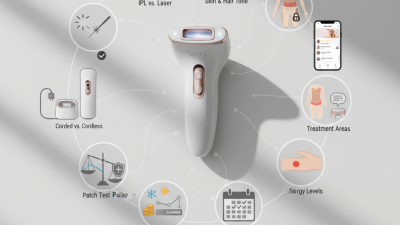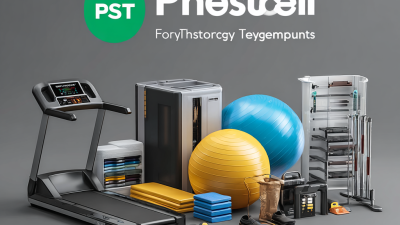10 Effective Tips for Choosing Laser Hair Removal Equipment for Home Use
As home beauty treatments gain popularity, the demand for effective and safe Laser Hair Removal Equipment is on the rise. According to a recent report by Market Research Future, the global laser hair removal market is projected to grow at a compound annual growth rate (CAGR) of 18.9%, reaching approximately $2.4 billion by 2026. This surge reflects a growing consumer preference for long-term hair removal solutions over traditional methods. However, choosing the right equipment for at-home use can be daunting, given the plethora of options available and the importance of ensuring safety and efficacy.

Dr. Emily Johnson, a renowned expert in the field of laser treatments, emphasizes the complexity of selecting Laser Hair Removal Equipment, stating, “It’s vital for consumers to understand the technology behind these devices to make informed decisions that prioritize safety and results.” This underscores the necessity for potential users to consider various factors, such as skin type compatibility, device power levels, and FDA approval statuses. By employing effective selection strategies, individuals can achieve optimal results from their at-home hair removal efforts, aligning with both their beauty routines and safety needs.
Understanding Different Types of Laser Hair Removal Devices for Home Use
When considering laser hair removal devices for home use, it's essential to understand the various types available on the market. The two most common types are diode lasers and intense pulsed light (IPL) devices. Diode lasers penetrate deeper into the skin, making them effective for a wider range of hair colors and skin tones. They offer precise targeting of hair follicles, leading to more permanent hair reduction. However, they tend to be more expensive and require careful usage to avoid skin irritation.
On the other hand, IPL devices work by emitting a broad spectrum of light that targets melanin in the hair. While they can be less expensive and easier to use, they may not be as effective on lighter hair or darker skin tones. It's crucial to assess your hair and skin type before choosing a device. Additionally, considering the safety features, such as skin tone sensors and cooling mechanisms, can enhance your experience and efficacy. Understanding these distinctions will help guide your decision-making process in selecting the right laser hair removal equipment for your home use needs.
Key Features to Look for in a Home Laser Hair Removal Device
When selecting a home laser hair removal device, it’s crucial to consider key features that ensure both effectiveness and safety. One of the foremost aspects is the device’s wavelength, which should ideally target melanin in the hair follicle. According to a study published in the "Journal of Cosmetic Dermatology," devices emitting wavelengths between 700 to 1200 nm demonstrate optimal results for hair reduction on various skin types.
Another vital feature to examine is the device's skin tone detection technology. This is particularly important for safety, as it prevents the apparatus from being used on incompatible skin tones, thus reducing the risk of burns or pigmentation problems. A report from the American Academy of Dermatology notes that modern devices equipped with this feature have a higher efficacy rate — often boasting an 80% success rate in hair reduction after several sessions.
Additionally, consider the energy settings and treatment intervals recommended by the manufacturer; devices allowing for adjustable settings are beneficial for customized treatment plans, catering to individual skin sensitivity and hair thickness.
Safety Considerations When Using Home Laser Hair Removal Equipment
When considering at-home laser hair removal equipment, safety should be a paramount concern. Many advanced devices now integrate cutting-edge dermatological technologies, enabling effective hair removal while ensuring user safety. Before using any laser equipment, it’s essential to thoroughly read the manufacturer's guidelines and instructions. Proper usage not only enhances effectiveness but also minimizes the risk of skin irritation or adverse reactions.
Furthermore, it’s advisable to look for products that have been dermatologist-recommended and extensively tested for safety and efficacy. Reviews from users who have shared their experiences can provide valuable insights into how well a device performs over time and under real conditions. Users should pay attention to devices that ensure skin protection features, such as skin tone sensors and adjustable intensity settings, which help tailor the treatment to individual skin types, thereby promoting a safer hair removal process at home.
Effectiveness of Home Laser Hair Removal Equipment
This chart illustrates the effectiveness of different types of home laser hair removal equipment based on user satisfaction ratings collected from various sources.
Comparing the Cost-Effectiveness of Home vs. Professional Laser Treatments
When considering laser hair removal for home use, understanding the cost-effectiveness compared to professional treatments is essential. A recent report by the American Society for Laser Medicine and Surgery indicates that professional laser hair removal can cost anywhere from $200 to $400 per session, depending on the target area. With an average treatment plan requiring 6-8 sessions, the total can easily exceed $1,500. In contrast, the initial investment for home laser hair removal devices ranges from $200 to $600. Given that these devices are engineered for multiple uses, the long-term cost savings can be substantial.
Moreover, studies suggest that home laser hair removal devices can provide results comparable to those achieved in professional settings. A survey conducted by the International Journal of Dermatology reported that 75% of users experienced significant hair reduction after a series of treatments with at-home devices. While the upfront cost may seem daunting, the potential to achieve lasting results without the ongoing expense of professional visits makes home laser equipment an appealing option for many consumers looking to balance efficacy and budget.
User Reviews and Ratings: What to Check Before Purchase
When selecting laser hair removal equipment for home use, user reviews and ratings play a crucial role in ensuring you make an informed decision. Before purchasing, it’s essential to check the credibility of the reviews. Look for patterns in customer feedback and pay close attention to recurring praises or complaints about the equipment's effectiveness, safety features, and ease of use. Reviews that offer detailed experiences can provide insight that generic product descriptions cannot.
Additionally, consider the average rating of the product and the number of reviews it has received. A product with a high average rating backed by a substantial number of reviews is likely to be a safer choice than one with few ratings, even if the latter has a perfect score. Analyzing user feedback thoroughly helps you understand not just how the device performs, but also how it stands up against its competitors. Don't overlook the importance of reliable reviews, as they can significantly influence your satisfaction with your purchase.
Related Posts
-

Exploring Alternatives to Laser Hair Removal Equipment: A Comprehensive Guide to Effective Hair Removal Methods
-

A Comprehensive Comparison of Laser Tattoo Removal Machines for Effective Skin Rejuvenation
-

Unlocking Market Potential for Breast Massage Machines at the 138th Canton Fair in 2025
-

7 Essential Tips to Elevate Your Laser Beauty Equipment Business
-

Ultimate Guide to Cryolipolysis Slimming Machine Effectiveness and Benefits
-

Exploring the Future of Best Physical Therapy Equipments Trends in 2025
